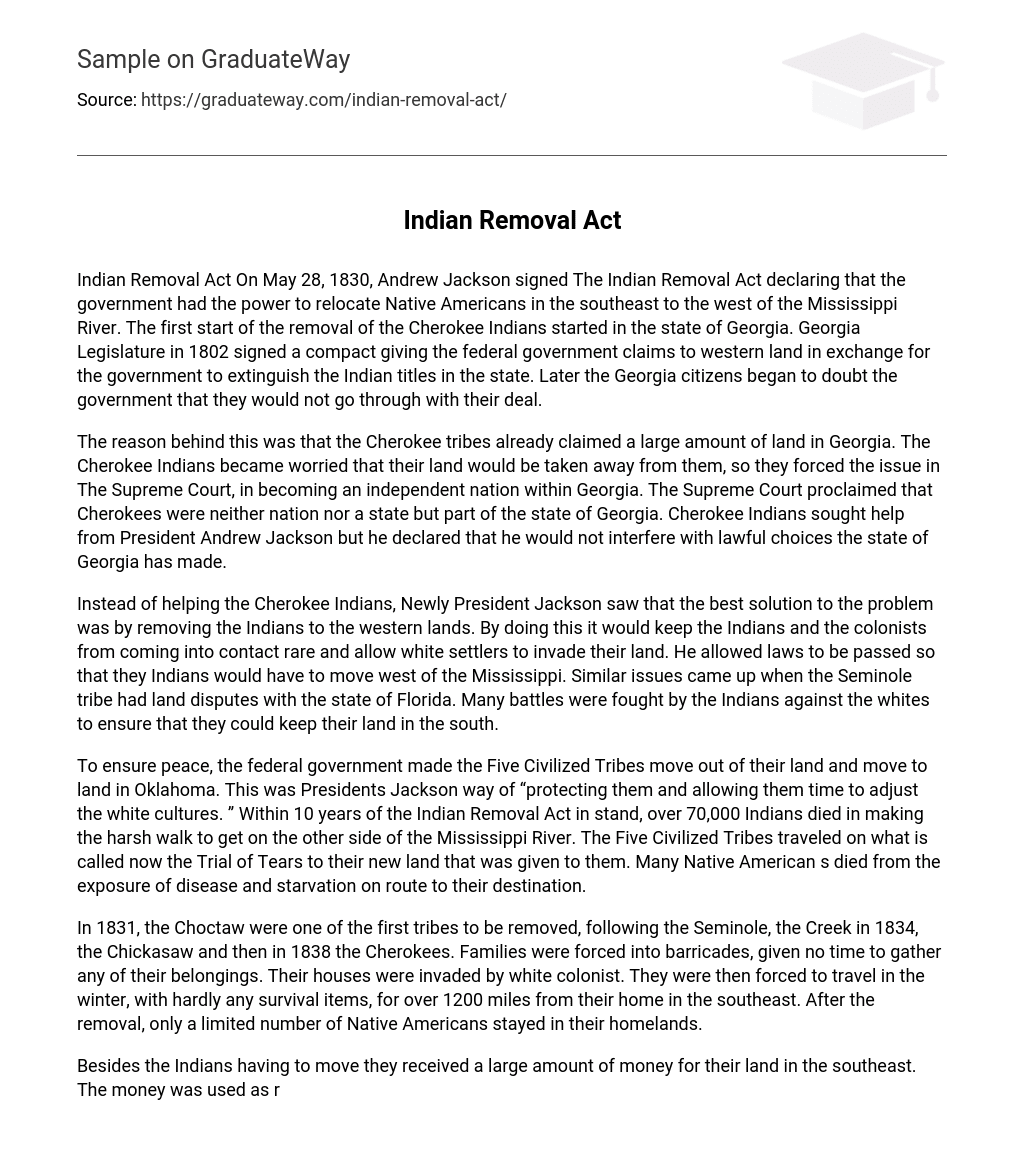The Indian Removal Act declaring that the government had the power to relocate Native Americans in the southeast to the west of the Mississippi River. The first start of the removal of the Cherokee Indians started in the state of Georgia. Georgia Legislature in 1802 signed a compact giving the federal government claims to western land in exchange for the government to extinguish the Indian titles in the state. Later the Georgia citizens began to doubt the government that they would not go through with their deal.
The reason behind this was that the Cherokee tribes already claimed a large amount of land in Georgia. The Cherokee Indians became worried that their land would be taken away from them, so they forced the issue in The Supreme Court, in becoming an independent nation within Georgia. The Supreme Court proclaimed that Cherokees were neither nation nor a state but part of the state of Georgia. Cherokee Indians sought help from President Andrew Jackson but he declared that he would not interfere with lawful choices the state of Georgia has made.
Instead of helping the Cherokee Indians, Newly President Jackson saw that the best solution to the problem was by removing the Indians to the western lands. By doing this it would keep the Indians and the colonists from coming into contact rare and allow white settlers to invade their land. He allowed laws to be passed so that they Indians would have to move west of the Mississippi. Similar issues came up when the Seminole tribe had land disputes with the state of Florida. Many battles were fought by the Indians against the whites to ensure that they could keep their land in the south.
To ensure peace, the federal government made the Five Civilized Tribes move out of their land and move to land in Oklahoma. This was Presidents Jackson way of “protecting them and allowing them time to adjust the white cultures. ” Within 10 years of the Indian Removal Act in stand, over 70,000 Indians died in making the harsh walk to get on the other side of the Mississippi River. The Five Civilized Tribes traveled on what is called now the Trial of Tears to their new land that was given to them. Many Native American s died from the exposure of disease and starvation on route to their destination.
In 1831, the Choctaw were one of the first tribes to be removed, following the Seminole, the Creek in 1834, the Chickasaw and then in 1838 the Cherokees. Families were forced into barricades, given no time to gather any of their belongings. Their houses were invaded by white colonist. They were then forced to travel in the winter, with hardly any survival items, for over 1200 miles from their home in the southeast. After the removal, only a limited number of Native Americans stayed in their homelands.
Besides the Indians having to move they received a large amount of money for their land in the southeast. The money was used as revenue for the tribes and to help to support schooling and the government. The Indian Removal Act is known to be one of the most tragic events in history. Early treaties signed by Americans and representatives insured that Indians tribes would have peace and assure that the lucrative fur trade would continue without interruption. After the Trails of Tears had ended, many Native Americans changed to Christianity. They found that customs of Christianity was similar to their own. Overall, the Indian Removal Act and the Trail of Tears will go down in history as one of the greatest tragedies and will leave a strain on the way people see President Jackson later on. Also there will be a dark cloud left over the way Native Americans and white see each other in America.
References
- http://loc. gov/rr/program/bib/ourdocs/indian. html www. studyworld. com/indian_removal_act_of_1830 www. sparknotes.
- com www. nationalhumanliescenter. com http://www. helium. com/items/1099551-indian-removal-act





